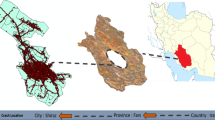Abstract
This paper suggests a framework that collects real-time public big data and reproduces them useful information such as crash likelihood to provide to drivers for their awareness of hazardous road under rainy weather conditions. A binary logistic regression model is applied to estimate driving environmental impact on freeway crashes. The driving environments are categorized as weather condition, traffic condition and road geometry. Eleven factors from the environment information are chosen for independent variables of the logistic regression analysis. The model proves that speed, cumulative precipitation and road geometry characteristics are correlated to the crash likelihood. Drivers would use the crash likelihood information for avoiding hazardous road, and vehicle navigation systems would add the information in their routing problem.
Access this chapter
Tax calculation will be finalised at checkout
Purchases are for personal use only
Similar content being viewed by others
References
Fridstrøm, et al.: Measuring the contribution of randomness, exposure, weather, and daylight to the variation in road accident counts. Accid. Anal. Prev. 27, 1–20 (1995)
Levine, N., et al.: Daily fluctuations in Honolulu motor vehicle accidents. Accid. Anal. Prev. 27, 785–796 (1995)
Chang, L.-Y., Chen, W.-C.: Data mining of tree-based models to analyze freeway accident frequency. J. Saf. Res. 36, 365–375 (2005)
Caliendo, C.,, et al.: A crash-prediction model for multilane roads. Accid. Anal. Prev. 39, 657–670 (2007)
Haghighi-Talab, D.: An investigation into the relationship between rainfall and road accident frequencies in two cities. Accid. Anal. Prev. 5, 343–349 (1973)
Brijs, T., et al.: Studying the effect of weather conditions on daily crash counts using a discrete time-series model. Accid. Anal. Prev. 40, 1180–1190 (2008)
Brodsky, H., Hakkert, A.S.: Risk of a road accident in rainy weather. Accid. Anal. Prev. 20, 161–176 (1988)
Eisenberg, D.: The mixed effects of precipitation on traffic crashes. Accid. Anal. Prev. 36, 637–647 (2004)
Keay, K., Simmonds, I.: Road accidents and rainfall in a large Australian city. Accid. Anal. Prev. 38, 445–454 (2006)
Yannis, G., Karlaftis, M.G.: Weather effects on daily traffic accidents and fatalities: a time series count data approach. In: Proceedings of the 89th Annual Meeting of the Transportation Research Board, pp. 10–14 (2010)
Bergel-Hayat, R., et al.: Explaining the road accident risk: weather effects. Accid. Anal. Prev. 60, 456–465 (2013)
Belmont, D., Forbes, T.: Effect of average speed and volume on motor-vehicle accidents on two-lane tangents. In: Highway Research Board Proceedings (1953)
Dickerson, A., et al.: Road accidents and traffic flows: an econometric investigation. Economica 67, 101–121 (2000)
Leutzbach, W.: Traffic accidents and traffic flow on the Frankfurt–Mannheim motorway–investigation of the relationship between traffic accidents and traffic flow. In: Hessisches Ministerium fur Wirtschaft und Verkehr (1966)
Gwynn, D.W.: Relationship of accident rates and accident involvements with hourly volumes. Traffic Q. 21, 407–418 (1967)
Zhou, M., Sisiopiku, V.: Relationship between volume-to-capacity ratios and accident rates. Transp. Res. Rec. J. Transp. Res. Board 1581, 47–52 (1997)
Nilsson, G.: Traffic safety dimensions and the power model to describe the effect of speed on safety. In: Bulletin-Lunds Tekniska Högskola, Inst för Teknik och Samhälle, Lunds Universitet, vol. 221 (2004)
Elvik, R., et al.: Speed and road accidents: an evaluation of the power model. The Institute of Transport Economics, Oslo (2004)
Garber, N.J., Gadirau, R.: Speed Variance and its Influence on Accidents. AAA Foundation for Traffic Safety, Washington, D.C. (1988)
Taylor, M.C., et al.: The effects of drivers’ speed on the frequency of road accidents, Transport Research Laboratory, Berkshire, AU (2000)
Solomon, D.: Accidents on main rural highways related to speed, driver, and vehicle, US Department of Commerce & Bureau of Public Roads, Washington, D.C. (1964)
Rock, S.M.: Impact of the 65 mph speed limit on accidents, deaths, and injuries in illinois. Accid. Anal. Prev. 27, 207–214 (1995)
Aljanahi, A.A.M., et al.: Speed, speed limits and road traffic accidents under free flow conditions. Accid. Anal. Prev. 31, 161–168 (1999)
Ossiander, E.M., Cummings, P.: Freeway speed limits and traffic fatalities in Washington State. Accid. Anal. Prev. 34, 13–18 (2002)
Wong, S.C., et al.: Would relaxing speed limits aggravate safety?: a case study of Hong Kong. Accid. Anal. Prev. 37, 377–388 (2005)
De Pauw, E., et al.: Safety effects of reducing the speed limit from 90 km/h to 70 km/h. Accid. Anal. Prev. 62, 426–431 (2014)
Ahmed, M., et al.: Bayesian updating approach for real-time safety evaluation with automatic vehicle identification data. Transp. Res. Rec. J. Transp. Res. Board 2280, 60–67 (2012)
Ahmed, M.M., Abdel-Aty, M.A.: The viability of using automatic vehicle identification data for real-time crash prediction. IEEE Trans. Intell.Transp. Syst. 13, 459–468 (2012)
Okamoto, H., Koshi, M.: A method to cope with the random errors of observed accident rates in regression analysis. Accid. Anal. Prev. 21, 317–332 (1989)
Zegeer, C.V., et al.: The Effect of Lane and Shoulder Widths on Accident Reductions on Rural, Two-Lane Roads, Kentucky Department of Transportation (1980)
Ogden, K.W.: The effects of paved shoulders on accidents on rural highways. Accid. Anal. Prev. 29, 353–362 (1997)
Knuiman, M.W., et al.: The Association Of Median Width and Highway Accident Rate, Washigton, D.C. FHWA-RD-93-046 (1993)
Fink, K.L., Krammes, R.A.: Tangent length and sight distance effects on accident rates at horizontal curves on rural two-lane highways. Transp. Res. Rec. 1500, 162–167 (1995)
KMA, December 2014. http://web.kma.go.kr/aboutkma/biz/observation02.jsp
Hosmer Jr., D.W., et al.: Applied Logistic Regression, 3rd edn. Wiley, Hoboken (2013)
Tukey, J.W.: Exploratory Data Analysis. Addison-Wesley, Reading (1977)
Acknowledgements
This work was supported by the National Research Foundation (NRF) grant funded by the Korea Government (MSIP) (NRF-2017R1A2B4008984).
Author information
Authors and Affiliations
Corresponding author
Editor information
Editors and Affiliations
Rights and permissions
Copyright information
© 2019 Springer International Publishing AG, part of Springer Nature
About this paper
Cite this paper
Chung, Y., Kim, S., Cheon, S. (2019). A Framework for Modelling Crash Likelihood Information Under Rainy Weather Conditions. In: Stanton, N. (eds) Advances in Human Aspects of Transportation. AHFE 2018. Advances in Intelligent Systems and Computing, vol 786. Springer, Cham. https://doi.org/10.1007/978-3-319-93885-1_76
Download citation
DOI: https://doi.org/10.1007/978-3-319-93885-1_76
Published:
Publisher Name: Springer, Cham
Print ISBN: 978-3-319-93884-4
Online ISBN: 978-3-319-93885-1
eBook Packages: EngineeringEngineering (R0)




